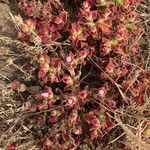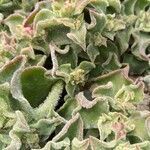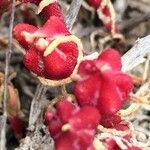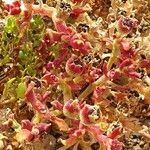Plants annual to biennial. Stems trailing, dichotomously branched, to 1 m. Leaves sessile or petiolate; petiole, ± clasping; blade ovate to spatulate, flat, 2-20 cm, margins undulate. Inflorescences terminal or axillary, cymes; proximal bracts opposite, leaflike; distal bracts alternate, reduced; flowering profusely. Flowers 7-10 mm diam.; hypanthium aging red, round; calyx lobes 5, unequal; petals 20-40, connate into tube, white, aging pink; stamens 30. Capsules coarsely papillate. Seeds 200, rough with minute tubercles. 2n = 18.
A succulent herb or shrub. It lies along the ground. It grows 10-20 cm high. It can spread to 1 m wide. The stems are stout. The leaves are oval or heart shaped and can taper to the tip. They are thick and flat with many large glistening lumps. They are 3-8 cm long by 5-20 mm wide. The flowers are white and produced close to the plant. They open in the sunlight. The fruit is a capsule that is star shaped.
Prostrate, succulent, annual herb, with a small non-flowering rosette of leaves, stems terete. Leaves flat, ovately racket-shaped, basal ones largest, ± 60 x 35 mm, margins undulate, epidermal bladder-cells very large. Flowers 15-30 mm diam., white, suffused with pink, petals, staminodes and stamens not very numerous. Fruit 5-locular.
Prostrate annual, forming large mats, up to 0.5 m high. Leaves flat, ovate-spathulate, covered in large, glassy bladder cells. Flowers cream-coloured, sometimes tinged pink at apex. Flowering time Feb.-Nov. Capsules pale golden-brown, 4-or 5-locular, valve wings inflexed over valves.
Annuals. Basal leaves forming a rosette. Prostrate annual. Leaves at base forming a small rosette, flat, ovate-spathulate, bladder cells large. Flowers white or pinkish, 15-30 mm diam. Fruits with valve wings inflexed over valves.












